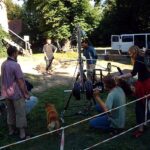Giecz is so far the only archaeological site in Poland filmed for the Discovery Channel. The unique 11th c. crypt, cemetery site and our Field School comprise an episode of the television series „Ancient Clues: Modern Discoveries in Forensic Archaeology” which will be broadcast on Discovery International and Discovery Canada in 2005.
„Ancient Clues” is a science documentary series that reveals new evidence from ancient human remains and attempts to piece together mysterious clues and disclose astounding stories of life and death in the remote past. Among other sites filmed for this series is Sweden’s Visby, Turkey’s Catalhoüyük and Gordion, Italy’s Pisa as well as sites in Belize and Honduras, China and Egipt.

The Pride of Poland
by NICHOLAS NICASTRO
Archaeology, Vol. 53, No. 2, March/April 2000, p. 96
The Poles on the beach of Lake Lednica don’t seem much concemed about the past. On summer days they converge from all directions, frolicking in their bikinis, walking their tiny dogs, picnicking on treats like pickled onion and lard sandwiches. There’s little sign that serious archaeological business is underway, both on the small island nearby and in the mud beneath the lake’s gentle swells, but if the archaeologists have their way, this area 150 miles west of Warsaw will emerge as the Polish equivalent of the Acropolis or the Roman Forum.
For it was here, both legend and excavation testify, that the founder of the Polish state, Mieszko I, first accepted Latin Christianity and erected his administrative capital in 966. Mieszko and his Piast descendants went on to carve out a medieval kingdom, roughly the same size as modern Poland, that was a political and military force to be reckoned with by the neighboring Russians, Germans, Czechs, and Byzantines. On the island, now called Ostrow Lednicki, Mieszko built a ring-fort some 460 feet in diameter, and crowned it with his residence, a fine stone palace, the country’s first monumental architecture.
„Welcome to this place, where Polish history began”, the First Piasts Museum’s Janusz Górecki says grandiloquently, going on to underline the site’s emotional and symbolic importance. He points with evident pride at the ramparts and remains of the palace and chapel, as well as at the bridgeheads (now under excavation) of two long-vanished timber spans that once connected the island with the mainland. It’s an emotion echoed by the team of divers from the University of Toruń, sifting the bottom of the lake and happily showing off the results: eleventh-century battle-axes, hafted spear-points, horse-bits, and jewelry, all preserved in the oxygen-poor silt.
This pride is also echoed by First Piasts Museum archaeobotanist Marek Polcyn, who (with his geologist wife Ilona) has documented intense resource exploitation and cultivation in the region both before and during the Piast residency. Indeed, according to Polcyn, the very name of the country is rooted in the old Slavic word pol, or field. „They cut down all the trees early on”, he recounts. „The region was highly developed economically, and was insulated by surrounding tribes from other early states”. This isolation perhaps explains why the lake area was rich and secure enough to become the nucleus of a new kingdom.
The virtual erasure of Poland from Europe’s nineteenth-century political map meant that much of the region’s early systematic archaeology was done by foreigners. „There’s a long-standing tradition of claiming Slavic monuments were built by Germans”, explains New York University archaeology doctoral student Thalia Gray. „Whenever a rampart or fort was found, it was German. Any Slavic pottery found there was made by Polish subjects of the Germans”. The need to reclaim Polish history for the Poles has laden the Lake Lednica project with symbolic capital. As the regular visits by Polish TV and troops of summer-camp kids suggest, the excavations have become exercises in modern nation-building for a land with a bitter recent history.
Meanwhile, Mieszko’s other early seats at Gniezno and at Poznań can also lay claim to the title of „cradle of the Polish state”. Gniezno became the seat of the nation’s archbishopric around 1000; as recently as this summer, excavator Hanna Kóčka-Krenz reported discovery of a tenth-century palace, possibly built by Mieszko, at Poznań. The event was eagerly covered by the local press there.
Modern Ostrow Lednicki has some important advantages over its rivals. It is located in the Wielkopolska Landscape Park — a protected lake district that also encompasses several traditional villages and an „Ethnographic Park” comprised of furnished eighteenth- and nineteenth-century thatched houses collected from all over the country. Whether or not the place can claim real historic priority is almost beside the point: the bucolic, uncluttered atmosphere and pristine lake have the allure of Avalon, inviting pious contemplation of one’s cultural patrimony. Of course, a cafe beside the lake serves kielbasa and eel smoked in an old steel footlocker. As the Poles know only too well from 40 years of communism, national pride can be filling stuff, but it still ain’t lunch.
NICHOLAS NICASTRO is an archaeologist and filmmaker based in Ithaca, New York. The nonprofit Salvia Foundation (212-439-8177, www.slavia.org) runs summer excavation field schools on Ostrow Lednicki and environs.
ARCHAEOLOGY Reprinted with permission of Archaeology Magazine, Vol. 53, No. 2
(Copyright the Archaeological Institute of America, 2000)




